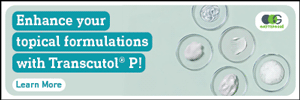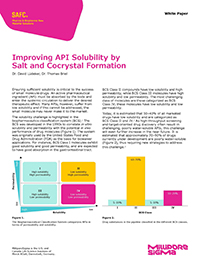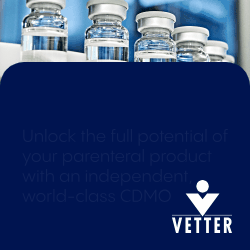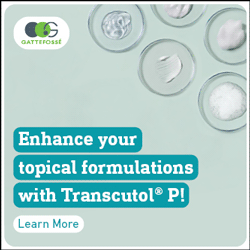Functional Excipients
WHITEPAPER - Improving API Solubility by Salt & Cocrystal Formation
Ensuring sufficient solubility is critical to the success of small molecule drugs. An active pharmaceutical ingredient (API) must be absorbed by the body and enter the systemic circulation to deliver the desired therapeutic effect. Many APIs,….
Comera Life Sciences Significantly Expands Intellectual Property Portfolio Strengthening the Proprietary SQore Platform
Comera Life Sciences Holdings, Inc. recently announced a significant expansion of its SQore patent portfolio with the issuance of four new patents and two new…
Acquisition of Solus BioTech Expands Croda's Specialized Pharma Business in Asia
Croda International Plc recently announced it has acquired Solus BioTech, a global leader in premium, biotechnology-derived materials, from Solus Advanced Materials…..
WHITEPAPER - Overcoming the Knowledge Gap: Long-Acting Injectables & Implantables
This whitepaper delves into the numerous benefits of long-acting drug delivery systems, including their ability to harness highly potent APIs, streamline development and intellectual property protection, and provide consistent drug release over extended periods.
Ardena & RiboPro Forge Strategic Alliance to Support the RNA Revolution With End-to-End Manufacturing of Advanced mRNA & LNP Solutions
Leading contract development manufacturer of nanomedicines, Ardena, has joined forces with mRNA and LNP technology specialists RiboPro to form a new strategic commercial alliance aimed at…
Lubrizol Licenses Award-Winning Apisolex™ Excipient to Welton Pharma to Develop a Novel Cancer Therapeutic
The Lubrizol Corporation recently announced the licensing of its novel excipient polymer technology, Apisolex™ excipient, to Welton Pharma (Welton). The license allows….
Croda Announces Two New Partnerships to Drive Sustainable Delivery Systems for the Pharmaceutical Industry
Croda International Plc recently announced it has signed two new partnership agreements that will help the pharmaceutical industry move toward a more sustainable supply chain for vaccine adjuvants…..
Ashland Announces Multifunctional Disintegrant for Improved Pharmaceutical Process Throughput
Ashland is introducing Polyplasdone Plus, a co-processed multifunctional direct compression superdisintegrant containing a glidant and lubricant. Saving time and simplifying development, the multifunctional disintegrant offers…
SPECIAL FEATURE - Outsourcing Formulation Development & Manufacturing: Putting Customers First
Contributor Cindy H. Dubin speaks with several leading CDMOs from around the globe on their unique development and manufacturing capabilities and technologies, and presents real-world examples of how they have put these to use to produce innovative compounds, lower development costs, and shorten time to market.
FORMULATION FORUM - PLGA – A Versatile Copolymer for Design & Development of Nanoparticles for Drug Delivery
Jim Huang, PhD, and Shaukat Ali, PhD, focus on the chemistry, properties, applications, and regulatory aspects of PLGA, and the future trends in the industry, especially those requiring the development of long-acting injectables for the treatment of a variety of rare diseases and for life cycle management.
EXCIPIENT TECHNOLOGY - A Juggling Act: Factors at Play in Your Choice of Solubilizing Parenteral Excipients
Joey Glassco, MBA, says the power of novel excipients such as Apisolex polymer could revolutionize the parenteral drug development landscape, effectively solubilizing a wide range of APIs without compromising on safety or stability.
Roquette Announces Strategic Investment & Innovation Agreement With Beren Therapeutics P.B.C.
Roquette recently announce a strategic investment with Beren Therapeutics P.B.C., and the launch of an innovation agreement to expand the full potential of Beren’s cyclodextrin technologies and their medicinal….
CureVac Announces Dosing of First Participant in Combined Phase 1/2 Study of Multivalent, Modified Influenza Vaccine Candidates Developed in Collaboration With GSK
CureVac N.V., a global biopharmaceutical company developing a new class of transformative medicines based on messenger ribonucleic acid (mRNA), recently announced the first participant was…
ION EXCHANGE EXCIPIENTS - Tackling Patient Compliance With Oral Drug Formulations Using Ion Exchange Resins
Amie Gehris explains how IERs solve various pharmaceutical formulation issues, including decreasing the bitter taste of many pharmaceutical drugs, improving patient outcomes by supporting compliance to treatment regimens, and providing new revenue streams for pharmaceutical companies.
Roquette Cuts Ribbon on $25-Million Pharmaceutical Innovation Center in the US
Roquette recently celebrated the grand opening of its new Pharmaceutical Innovation Center, located near Philadelphia, PA, right in the heart of the United States’ Northeastern pharmaceutical corridor…..
SPECIAL FEATURE - Excipients: Their Future Could Lie in Generics
Contributor Cindy H. Dubin highlights the innovative work being done by several leading companies and exemplifies the importance of excipients to the future of drug development.
FORMULATION FORUM - Tackling Challenging Molecules by Spray Drying: Making the Impossible Possible
Jim Huang, PhD, and Shaukat Ali, PhD, focus on spray drying technology with special reference to polymers and solvents selection, processing conditions, and the challenges with downstream manufacturing, stability, and degradation of APIs in oral dosages.
MICROCRYSTALLINE CELLULOSE - N-nitrosamine Risk Assessments for Oral Dosage Forms
Takako Koyamatsu, Shohei Mikami, PharmD, Obata Kenji, and Julia Shmyrova show how Ceolus™ demonstrated a very low level of nitrite and nitrate that can allow mitigating nitrosamine formation in the drug products with secondary or tertiary amines.
LIPID-BASED EXCIPIENTS - Misconceptions About Lipid-Based Drug Delivery
Rollie Fuller and Ron Permutt provide formulators confidence in using LBDDS as part of formulation development programs, by demonstrating their benefits and key functional mechanisms when used and addressing commonly misrepresented, misinterpreted, and misunderstood LBDDS topics.
Comera Life Sciences Announces Expansion of Patent Portfolio Underlying Core Excipient Technology
Comera Life Sciences Holdings, Inc. recently announced the expansion of its patent portfolio with one new patent granted in South Korea and two Notices of…
What are functional excipients?
The global pharmaceutical excipients market was valued at $7.7 billion in 2020 and is expected to reach $11.2 billion by 2026. Functional excipients are witnessing a strong demand as companies supply a wide range of functional excipients that help manufacturers produce cost-effective, high-quality, finished pharmaceutical product. Many industry experts point to a widening demand and use of organic pharmaceutical excipients. These organic excipients include oleochemicals, petrochemicals, proteins, carbohydrates, and others. Additionally, binders and functional excipients are witnessing a strong demand. Regarding delivery route, it is the topical segment that is witnessing fast growth in the global pharmaceutical excipients market, as topical drug delivery is witnessing a significantly stronger progression because of its ability to surpass the metabolism pathways of the stomach and liver.
However, the high cost associated with the drug development process will impede the growth rate of the pharmaceutical excipients market. Additionally, strict government regulations have hindered the pharmaceutical excipients market growth. Safety, quality concerns, and lack of awareness will further challenge the market in the forecast period mentioned above.
This is particularly true for novel excipients, which do have technical, therapeutic, and commercial benefits in oral drug delivery. Despite their formulation-enhancing benefits, novel excipients are sacrificed early in development because of a lack of precedence of use.
Without an independent pathway to allow new excipients or new uses for existing excipients into drug products, except when associated with a drug filing, there are limited tools available for pharmaceutical companies to formulate better performing, and in many cases, life-saving drugs. Meanwhile, drug manufacturers are reluctant to use new excipients and take on the additional layer of scrutiny from regulatory agencies to demonstrate full excipient characterization, safety, quality, function, and appropriateness of use.
Functional Excipients and the FDA
The Food & Drug Administration (FDA) has acknowledged that the lack of novel excipients is indeed a problem. In September 2021, the Agency announced the Novel Excipient Review Pilot Program, which will select and review four novel excipients in the next two years using a new pathway. This will allow manufacturers to obtain an FDA review prior to the use of the novel excipient in a drug formulation.
The FDA’s recent stance and acceptance that the novel excipients are critical in development of new drug candidates, the perceptions around the novel excipients are being changed as the Agency continues to embrace the facts that the pharma industry is in dire need of new excipients for bringing the innovative drugs to the market faster. This is the first time in history that the agency is opening doors for novel excipients to be freely evaluated and used in the innovative formulations for NCEs.
Note, though, that this is not an excipient approval process; the novel excipient would still be evaluated as part of the overall drug product approval. In the next 3 to 5 years, we can expect to see an acceleration in the examination of the composition and purity of excipients.














